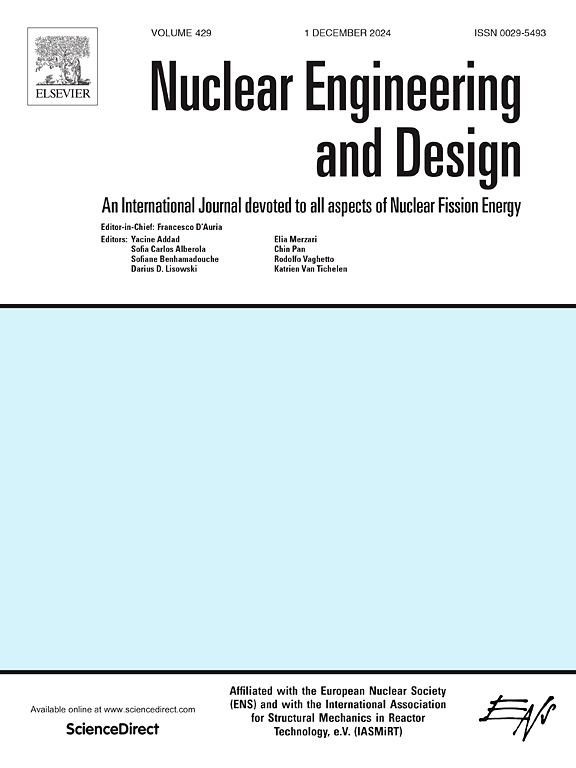利用HPR1000裂变室探测器信号动态测量棒值的可行性研究
IF 1.9
3区 工程技术
Q1 NUCLEAR SCIENCE & TECHNOLOGY
引用次数: 0
摘要
控制棒价值测量是反应堆物理启动试验的重要内容之一。目前,世界范围内的核电站普遍采用基于非补偿离子室信号的动态棒值测量(DRWM)方法,这种方法造成了一个功率量程检测器暂时不可用和零功率物理测试量程可能不足的问题。具有较宽测量范围的裂变室探测器可以向数字控制系统传输有效信号,使其应用于DRWM技术成为可能。基于OpenMC和PCM建立了HPR1000前堆裂变室探测器信号的计算模型和相应的DRWM空间校正因子,并利用防城港3号机组和4号机组第一周期的实测数据对计算模型进行了验证。结果表明,控制棒插入过程中电流变化的计算值与实测值一致,采用裂变室检测信号的DRWM控制棒与功率量程检测信号及理论预测值吻合较好,证明了裂变室检测信号在DRWM中应用的可行性。本文章由计算机程序翻译,如有差异,请以英文原文为准。
Study on the feasibility of dynamic rod worth measurement using fission chamber detector signal in HPR1000
The control rod worth measurement is one of the most important items during the reactor physical startup tests. Currently the dynamic rod worth measurement (DRWM) based on the signal from non-gamma compensated ion chamber is generally applied on worldwide nuclear power plants, which results in the temporary unavailability of one power range detector and possible insufficiency of zero power physical test range. The fission chamber detector with broader measuring range can transmit effective signal to the digital control system and makes it possible to be applied on the DRWM technique. The calculation model of the HPR1000 ex-core fission chamber detector signal and also the corresponding DRWM spatial-correction factors are built based on OpenMC and PCM and the verification of the calculation model is launched using the measured data from the first cycle of FANGCHENGGANG Unit 3 and Unit 4. The result shows that the calculated and measured variation of current during insertion of control rod are consistent and the DRWM control rod worth using fission chamber detector signals agrees well with that using power range detector signals as well as the theoretical prediction, which proves the feasibility to apply fission chamber detector signals in DRWM.
求助全文
通过发布文献求助,成功后即可免费获取论文全文。
去求助
来源期刊

Nuclear Engineering and Design
工程技术-核科学技术
CiteScore
3.40
自引率
11.80%
发文量
377
审稿时长
5 months
期刊介绍:
Nuclear Engineering and Design covers the wide range of disciplines involved in the engineering, design, safety and construction of nuclear fission reactors. The Editors welcome papers both on applied and innovative aspects and developments in nuclear science and technology.
Fundamentals of Reactor Design include:
• Thermal-Hydraulics and Core Physics
• Safety Analysis, Risk Assessment (PSA)
• Structural and Mechanical Engineering
• Materials Science
• Fuel Behavior and Design
• Structural Plant Design
• Engineering of Reactor Components
• Experiments
Aspects beyond fundamentals of Reactor Design covered:
• Accident Mitigation Measures
• Reactor Control Systems
• Licensing Issues
• Safeguard Engineering
• Economy of Plants
• Reprocessing / Waste Disposal
• Applications of Nuclear Energy
• Maintenance
• Decommissioning
Papers on new reactor ideas and developments (Generation IV reactors) such as inherently safe modular HTRs, High Performance LWRs/HWRs and LMFBs/GFR will be considered; Actinide Burners, Accelerator Driven Systems, Energy Amplifiers and other special designs of power and research reactors and their applications are also encouraged.
 求助内容:
求助内容: 应助结果提醒方式:
应助结果提醒方式:


